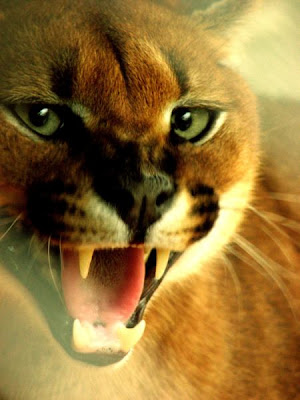
Caracal
The page is split into several sections for tech reasons with links to the next page.
Introduction
This is the cat that features in the well-known phrase, ‘to put the cat amongst the pigeons’. This harks back the era of Indian princes and maharajahs who, it is said, kept cheetahs and caracals as hunting animals. I have already written an article on hunting with cheetahs. Cheetahs are relatively friendly and trainable. This cat is described as fiercely territorial and sulky and irritable in confinement. They are also described as ‘easily tamed’ and adaptable to living with humans, which supports the view that they were used as hunters by people. In the USA, some people today – 2010 – do keep them as cat companions.
Although they were used to entertain the wealthy of India by keeping them to hunt small game, the extract below from: The Naturalist’s Library, I. Mammalia, Volume 2 By William Jardine dated 1834, indicates that there was little evidence of it at that time. However, when ‘taken young’ and reared by people and therefore socialised it can be trained.
One pastime was employing tame caracals to catch pigeons, as many as possible, while they were on the ground feeding. Apparently, a skillful caracal could kill almost a dozen before the rest flew off. A caracal amongst pigeons caused panic and chaos amongst the birds, hence the expression, ‘cat among the pigeons’.
This cat is or was known as the lynx or caracal lynx but is in no way a lynx. The lynx lives in colder climates than this cat species and the caracal has longer legs and a slimmer appearance than the lynx. Studies have separated the caracal and lynx in terms of scientific classification. Most recent studies using DNA profiling have concluded that it is closest to the African golden cat Caracal aurata and serval Leptailurus serval.
This slender cat of medium size is known, perhaps for two major attributes (a) its long, black, ear tufts at the tip of its ears and (b) its ability to leap vertically from a standing position to a height of about 3 metres and more to catch birds in flight.
A visitor and welcome contributor to this site has been involved with caracals. See her post here: Living With And Understanding Servals And Caracals.
The Name
The scientific name is: Caracal caracal (Schreber 1776). The word, ‘caracal’ is believed to be derived from Turkish. It is the only member of the genus Caracal.
Other names include:
- Persian Lynx
- Egyptian Lynx
- African Caracal
- Asian Caracal
- Desert Lynx
- Garah gulak (Turkish) – means ‘black ear’
- Red cat (Africa)
- Rooicat (Africa)
- Red lynx (Africa)
- African lynx (Africa)
- Siyeh gush (Hindi and Persian)
- Ech (Ladakh)
- Siya gush
- ngam ouidenanga (‘gazelle cat’ – Niger on account of it hunting Dorcas gazelles.
- Syahgosh (N.India and Pakistan)
- Shyahgosh (N.India and Pakistan)


Pretty fine publish. I just just simply stumbled upon your website not to mention wished to say i always have really enjoyed reading your blog site content. Anyway I’ll turn out to be subscribing to all your feed not to mention I hope most people publish once more soon.